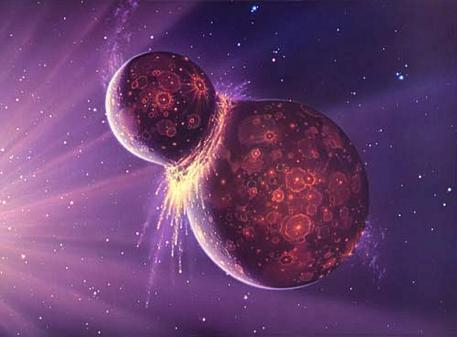Small Big Bang
How was the Moon created?
 © NASA/Joe Tucciarone
|
Illustration of the collision theory. A body the size of Mars probably hit the young Earth. As a result, material from the rocky mantle of the celestial body and of the Earth was hurled into space. This collected in the shape of a ring on a path closely orbiting the Earth, where it then gradually 'clumped together' to form the Moon.
The Moon – a "heap of rubble"
The current preferred hypothesis regarding the Moon's formation is the 'collision' theory. It is, so far, the best at explaining how compositions of rock from the Earth and rock from the Moon differ. According to the collision theory, at the dawn of the Solar System a heavenly body the size of Mars hit the young Earth. As a result, material from the rocky mantle of the heavenly body and of the Earth was hurled into space. This collected in the shape of a ring on a path closely orbiting the Earth where it then gradually ‘clumped together’ to form the Moon.
German Aerospace Center
Small Big Bang
How was the Moon created?
 © NASA/Joe Tucciarone
|
Illustration of the collision theory. A body the size of Mars probably hit the young Earth. As a result, material from the rocky mantle of the celestial body and of the Earth was hurled into space. This collected in the shape of a ring on a path closely orbiting the Earth, where it then gradually 'clumped together' to form the Moon.
The Moon – a "heap of rubble"
The current preferred hypothesis regarding the Moon's formation is the 'collision' theory. It is, so far, the best at explaining how compositions of rock from the Earth and rock from the Moon differ. According to the collision theory, at the dawn of the Solar System a heavenly body the size of Mars hit the young Earth. As a result, material from the rocky mantle of the heavenly body and of the Earth was hurled into space. This collected in the shape of a ring on a path closely orbiting the Earth where it then gradually ‘clumped together’ to form the Moon.
German Aerospace Center






